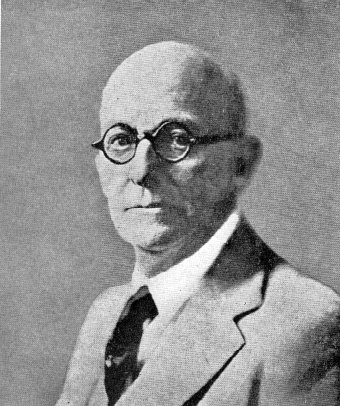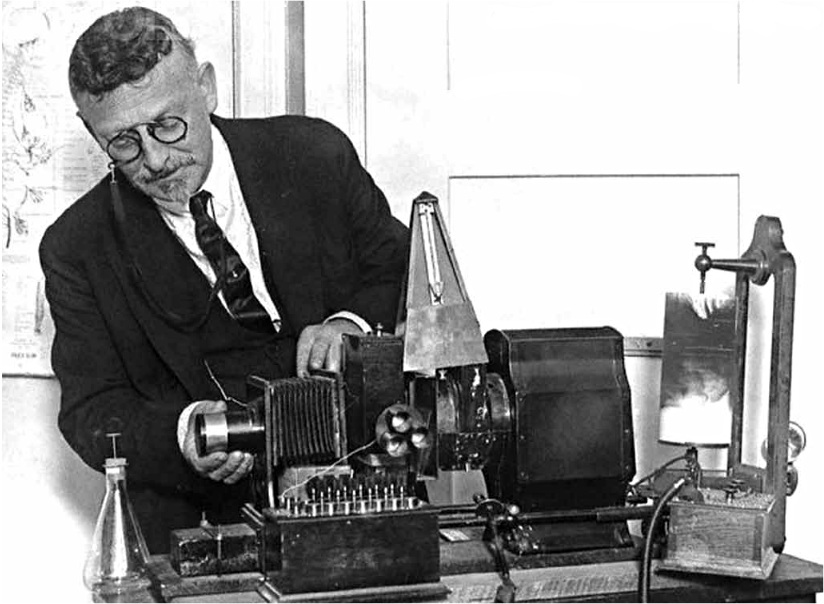The use of rheostats for tuning, involved a problem of practical use. One could not be sure that a previous setting would be exactly duplicated in the future. Even with the aid of a pointer on the rheostat knob and a scale marked on the panel, there was always the possibility that the sliding arm on the rheostat would be set slightly higher or lower than before, when the operator wanted to duplicate a previous tuning. To eliminate this problem, the tuning mechanism was changed. Instead of rheostats, selector switches were adopted. Fixed resistances were connected between each adjacent pair of switch contacts, as shown in the accompanying diagram. All resistances used between contacts of one rheostat were of the same resistance value, designated as ohms. In this way, use of the switch knob determined how many equal units of fixed resistance were placed in the circuit. For example, if the switch knob was turned to place the switch arm at position No. 5, then three of the fixed resistances were placed in the circuit. Similarly, if the switch knob was turned so as to place the switch arm at position No. 6, there would then be six units of fixed resistance included in the circuit. Usually the switches that were used gave a choice of 10 or 11 positions, numbered from zero to 9 or zero to 10. The resistances used had to be of the non-conductive type, and preferably of very close tolerance with respect to the resistance value.
Previously when rheostats were used, the rheostat dials were usually marked from zero to 100 in 1-unit or 2-unit steps. This range of 100 units could be duplicated by using two selector switches as shown in the accompanying diagram -- in place of a 100-ohm rheostat, the left-hand switch would have 19-ohm resistors between each adjacent pair of contact points, while the right-hand switch would have 1-ohm resistors between each pair of adjacent contact points. In this way, each resistance value from zero to 100, in steps of 1 ohm (the customary unit of electrical resistance measurement) could be included in the circuit by using the appropriate settings for the two switches. Correspondingly, two rheostats in series were replaced by four selector switches in series.
In an early period each resistance step was represented by a switch contact point mounted on a panel in the form of a screw having a large flat head. The heads were installed on the curve of an arc; the switch had a metal arm bent down at one end to make contact with the flat heads -- the other end of the arm had a collar and set screw for attachment to the switch shaft or axle, which was rotated by a knob. Later this rather cumbersome arrangement [16] was superseded by the use of rotary single-gang selector switches in which the arm and all contact points are contained inside the switch housing. From this housing protrude the contact connections and the shaft for changing the switch setting.

Because of Dr. Abrams' experience with tuning rates derived from the use of rheostats, he assumed that it was the quantity of resistance in the circuit which tuned the emanations coming from the human body, and from other organisms and types of matter. This assumption was accepted for many years by his followers and successors, but was later proven to be a fallacy. There was another factor in the use of the rheostat, which went unrecognized for many years. It will be discussed in a later instalment, devoted to the theory of radionic tuning.
MEASUREMENTS OF AMPLITUDE OR VOLUME
The inauguration of tunings for disease radiations as outlined previously in this series, was a major, even a revolutionary advance; but there was a further need -- some means to determine the magnitude of each radiation detected. Before this was found, the operator could get some idea of the magnitude through variations in the apparent strength of the percussion reflex, but this was not at all specific and depended too much upon the interpretation of the operator.
It was then learned that once the tuning rate of an incoming radiation had been ascertained and placed on the instrument panel, another rheostat could be brought into use to find the relative strength of the radiation being detected. This auxiliary rheostat was used to extinguish the reaction -- if the magnitude of the incoming radiation was small, a low setting of the rheostat would cause the reaction to disappear. If on the other hand the magnitude [17] of the incoming radiation was large, then the rheostat would have to be advanced to a considerably higher setting, adding more resistance to the circuit, before the reflex action disappeared. Thus for the first time it became possible to measure disease radiation electronically!
MEASURING ORGANIC CONDITIONS
Later, when tunings were found for radiations from body organs, the measurement process was applied to the determination of extent of organ function, since the strength of radiation from an organ was found to be indicative of the condition of the organ and of its extent of function. Then the operator could determine which organs were functioning normally, which were below par in function (and just how much below par for each deficient organ) and which if any were functioning at an abnormally high rate (over-active).
For even more precise measurements of extent organ function, or of magnitude of disease radiation, two or more rheostats could be used in series, for example, a 100-ohm rheostat for gross measurements and a 1-ohm rheostat for fine measurements. The measuring rheostat or rheostats could be connected in series with the tuning rheostats, but had to be an a different position on the vertical (top to bottom) axis on the instrument panel from that occupied by the tuning rheostats. In other words, the measurement rheostats had to be placed either above or below the row of tuning rheostats -- ordinarily they were placed below the rheostats used for tuning. If placed on the same horizontal row as the tuning controls, the rheostats intended for measurement purposes ceased to serve these purposes and instead became part of the tuning mechanism. It was possible also to use other than series connections between the tuning controls and the measurement controls, provided that the pre-requisite of keeping the two types of controls on separate horizontal rows was observed.
When tuning rheostats were replaced with selector switches, some instruments makers continued to use rheostats for volume measurement purposes, while others replaced them with selector switches to which a series of fixed resistances were connected as with the tuning controls.
(To be continued.)
* * *
"PROPER BREATHING oxidizes the blood stream. That is what so many of us need. The oxidation system has run down and the toxins in the body are not burned up. We feel run down and old. While we are diligently seeking to take care of the spirit it would be well to take care of the physical body at the same time. When we start the study of the inner wisdom one of the first things we learn is that the body is truly the temple of the living God. Too often we come to the strange conclusion that there is something evil about the physical body -- that we must try to rise above it. This is not in keeping with the laws of nature."
The Yada di Shi'ite
Continue with "The History and Development of Radionics" (Part IV)

Further Reading
- Abrams, Albert. New Concepts in Diagnosis and Treatment: Physico-clinical Medicine, the Practical Application of the Electronic Theory in the Interpretation and Treatment of Disease: with an Appendix on New Scientific Facts. San Francisco, Calif: Philopolis Press, 1916. Print. [Digital: <http://catalog.hathitrust.org/Record/001588073>; reprints are available through BSRF in our classic xerographic format: <#B0210, "New Concepts in Diagnosis and Treatment">]
- Abrams, Albert. Human Energy. San Francisco: Philopolis Press, 1914. Print. [Digital: <http://catalog.hathitrust.org/Record/008904901>; reprints are available through BSRF in our classic xerographic format: <#B0211, "Human Energy">]
- Abrams, Albert. Spondylotherapy: Physio and Pharmacotherapy and Diagnostic Methods Based on a Study of Clinical Physiology. San Francisco: Philopolis Press, 1914. Print. [Digital: <http://catalog.hathitrust.org/Record/002089090>; reprints are available through BSRF in our classic xerographic format: <#B0177, "Spondylotherapy">]
An introductory review of Abrams and his work can be found in
"ERA: Electronic Reactions of Abrams" (#B0025).

